The Swiss franc (French: Franc suisse; German: Schweizer Franken'; Italian: Franco svizzero; Romansh: Franc svizzer) is the official currency and legal tender in Switzerland and Liechtenstein, as well as the Italian exclave, Campione d'Italia. Although it is not legal tender in Büsingen am Hochrhein (the legal tender is the euro), it is still widely used there. The Swiss National Bank issues the banknotes, which were printed by Orell Füssli Arts Graphiques SA, while Swissmint issues and produces the coins.
This currency is the only European currency denominated in francs. The subunit of the franc, equal to 1/100th of a franc, is called a rappen (German), centime (French), centesimo (Italian), or rap (Romansh). The code of the currency, which is used by banks and other financial institutions is CHF (CH standing for "Confoederatio Helvetica"), though Fr. is used by many businesses and advertisers. A small amount of these use SFr.
Switzerland, having four official languages, uses Latin inscriptions on its coins to remain language neutral.
History[]
Pre-franc[]
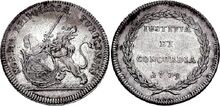
Currency from the Canton of Zürich.
Before the establishment of the Helvetic Republic in 1798, about 75 places were producing coins, which includes the 25 cantons and half-cantons, 16 cities, and abbeys. This resulted in about 860 different coins in circulation at the time, with different values, denominations, and systems.
Introduction of the franc[]
During 1798, the Helvetic Republic was established. With its introduction, it created a currency based on the Berne thaler, being subdivided into 10 batzen or 100 rappen. This franc was an equivalent to 6¾ grams of silver, or 1½ French francs. It was issued up until the disestablishment of the Helvetic Republic in 1803, but served as a model for the cantonal currencies that followed.
Reintroduction[]
Though 22 cantons and half-cantons had issued coins from 1803 to 1850, less than 15% of the currency being circulated in Switzerland was produced locally; a vast majority was foreign, mainly brought to the area by mercenaries. In addition to this, some private banks began issuing the first banknotes, so in total, about 8000 different coins and banknotes were being circulated at the time, which made the monetary system extremely complicated.
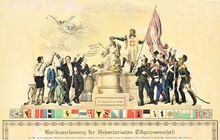
The Swiss Federal Constitution gave the government the exclusive right to issue currency.
To solve the complicated system, the Swiss Federal Constitution of 1848 stated in articles 38 and 39 of chapter one, that the Federal Government was the only authority allowed to produce currency in Switzerland. Two years later, this was followed by the Federal Coinage Act, which was passed by the Federal Assembly on May 7, 1850, which officially introduced the franc as the monetary unit of Switzerland. The Swiss franc was introduced at par to the French franc. It replaced numerous different currencies being issued by the Swiss cantons, some of which had been denominated as francs which were worth 1½ French francs.
During 1865, Belgium, France, Italy, and Switzerland formed the Latin Monetary Union (LMU), and agreed to value their national currencies at a standard of 4.5 grams of silver or 0.290322 grams of gold. Even after the monetary union's decline in the 1920s and its official end in 1927, the Swiss franc remained using this standard until September 27, 1936, when the franc suffered its only devaluation during the Great Depression. It was devalued by 30%, which was followed by the devaluations of the pound sterling, French franc, and United States dollar. During 1945, Switzerland joined the Bretton Woods system, and pegged the franc to the United States dollar at a rate $1 equaling 4.30521 francs. In 1949, this was changed to $1 equaling 4.375 francs.

CHF vs. the euro (top) and USD from 2003 to 2006.
From June 2003 to 2006, the exchange rate of the franc with the euro was stable at a value of about 1.55 francs equaling a euro, so that the Swiss franc has gone up and down with the euro against the United States dollar and other currencies. During March 2008, the Swiss franc went above one United States dollar for the first time. In March 2011, it went past the $1.10 mark (0.91 CHF per dollar). Only a few months later, in June, the franc went past the $1.20 mark (0.833 CHF per dollar) as investors looked for safety with the Greek-sovereign debt crisis which is still occurring.
Historically, the Swiss franc has been considered a safe-haven currency (hard currency), with an extremely low inflation rate and a legal requirement that a minimum of 40% be backed by gold reserves. This link to gold, which started during the 1920s, was ended on May 1, 2000 through a referendum. By 2005, after a gold selling program, the Swiss National Bank had in its possession 1290 tons of golds in reserves, which was equal to 20% of its values.
Coins[]
First franc[]
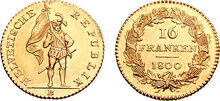
Sixteen-franc coin from 1800.
From 1798 to 1803, the Helvetic Republic issued coins denominated in 1 rappen, ½ batzen, 1 batzen in billon, 10 batzen, 20 batzen, and 40 batzen in silver, and 16 franken and 32 franken in gold. These coins were minted in Basel, Bern, and Solothurn. With the introduction of the Act of Mediation, the Helvetic Republic fell along with its currency.
Swiss Confederation issues[]
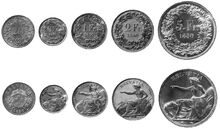
The higher denominations of the 1850s franc.
During 1850, with the reintroduction of the Swiss franc, coins were introduced with denominations of 1 rappen, 2 rappen, 5 rappen, 10 rappen, 20 rappen, ½ franc, 1 franc, 2 francs, and 5 francs. Of which, the 1 and 2 rappen coins were composed of bronze, the 5, 10, and 20 rappen coins in billon, and the franc denominations in .900 silver. From 1860 to 1863, the silver standard was reduced, and therefore, .800 silver was used, which happened before the French standard of .835 fineness was adopted for the silver coins with the exception of the 5 franc coin (which had remained at .900 fineness) during 1875. During 1879, the 5 and 10 rappen coins transitioned from billon to cupronickel, while the 20 rappen coin replaced billon with nickel.
Due to Switzerland's neutrality in World War I and World War II, Swiss coinage was not effected much, with brass and zinc coins only temporarily being issued. During 1931, the 5 franc coin was reduced in size from 25 grams to 15 grams, due to its reduction of silver. In 1932, nickel replaced the cupronickel used in the 5 and 10 rappen coins.
During the 1960s, due to the linkage of the Swiss franc to the devaluing United States dollar, the prices of internationally traded goods rose dramatically. The silver in a coin exceeded its value, and many of these coins were sent to different countries for smelting, which convinced the Federal Council to make this act illegal. However, the law had very little effect, and the melting of Swiss coinage only decreased when the collectible value of the remaining francs had again exceeded material value.
The 1 rappen coin was used up until 2006, although in decreasing quantities, but did not play a significant role in the monetary economy in the final quarter of the 20th century (1975–2000). People and groups who used the 1 rappen coin for monetary purposes could obtain these coins at face value, but anyone else would have to pay an additional four rappen per coin to cover costs of production, which had exceeded the coin's face value for a numerous amount of years. In the 1970s and 1980s, the coin was eventually disused, but was officially withdrawn from circulation and declared no longer legal tender on January 1, 2007. The 2 rappen coin, which was not minted since 1974, was demonetized on January 1, 1978.
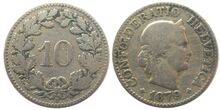
Ten rappen from 1879.
Since 1879, the designs of most coins of the Swiss franc have changed very little. The most changed denomination was the 5 franc coin, which had changed its designs in 1888, 1922, 1924 (minorly), and 1931 (mainly a reduction in size). A new design for the bronze 1 and 2 rappen was used beginning in 1948. Coins that depicted a ring of stars, such as the ½, 1, 2, and 5 franc coins, were modified from displaying 22 stars to 23 during 1983. The reason for this was the introduction of Jura in 1979 as the 23rd, as the stars represent each canton. The only coin that has changed the least since 1879 is the 10 rappen coin (except from 1918–1919, 1932–1939), retaining its original composition, size, and design until 2011, and are still legal tender and found in circulation.
Current coins[]
All Swiss coins produced are language-neutral, when regarding the four official languages of Switzerland, by featuring only numerals, the abbreviation Fr., and the Latin phrases "Helvetia", "Confœderatio Helvetica" (depending on the denomination) or the inscription "Libertas" on small coins. The name of the engraver of the coins is displayed on coins which depict the standing Helvetia or the 5 franc coin.
In addition to the general circulation issues, numerous commemorative coins have been issued in silver, gold, and other metals. The coins are not legal tender, but can be exchanged for their face value at post offices, and national or cantonal banks. Their material or collectors' value exceeds the face value. The highest denominated coin generally circulated equals 5 francs, but numerous commemorative coins exceed this in face value.
Image |
Value |
Diameter |
Thickness |
Mass |
Composition |
Obverse |
Reverse
|
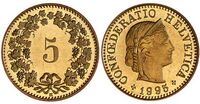
|
5 rappen | 17.15 mm | 1.25 mm | 1.8 g | Aluminum bronze (92% copper, 6% aluminum, 2% nickel) | Libertas head, "Confoederatio Helvetica", year | Value, wreath |
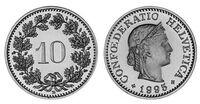
|
10 rappen | 19.15 mm | 1.45 mm | 3 g | Cupronickel (75% copper, 25% nickel) | ||

|
20 rappen | 21.05 mm | 1.65 mm | 4 g | |||
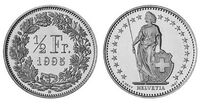
|
½ franc (50 rappen) | 18.2 mm | 1.25 mm | 2.2 g | Standing Helvetia | Value, year, wreath | |
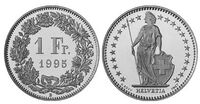
|
1 franc | 23.2 mm | 1.55 mm | 4.4 g | |||
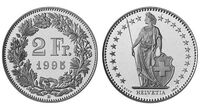
|
2 franc | 27.4 mm | 2.15 mm | 8.8 g | |||
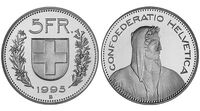
|
5 franc | 31.45 mm | 2.35 mm | 13.2 g | Alpine herdsman | Value, year, branches, Swiss coat of arms |
Commemorative coins[]

A commemorative Swiss coin from 2009.
The Swiss Confederation issued its first commemorative coin in 1857, on the occasion of a Schützenfest (shooting festival) being held in Bern. These coins, known as shooting thalers, are even minted up to this day in commemoration of each different festival. During 1936, the first non-shooting commemorative coin was made, and commemorative coins were issued occasionally. From 1974, the Swissmint has introduced new commemorative coins annually. Coins at face values of 10, 20, and 50 francs are currently being issued, and can be exchanged for their face value, but are not considered legal tender.
During 1981, Liechtenstein, as an official user of the Swiss franc, was given permission by the Federal Department of Finance to mint its own coins and put them into circulation. This grants the country the ability to mint commemorative coins to mark special occasions. However, these coins are only valid to use in Liechtenstein.
Banknotes[]
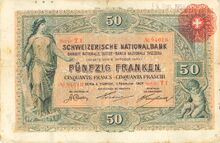
A banknote of the first series.
During 1907, the Swiss National Bank was established, and took over issuance of banknotes from the cantons and banks. The first series introduced banknotes in the denominations of 50, 100, 500, and 1000 francs. In 1914, the 5 and 20 franc banknotes were introduced as a part of Switzerland's series 2 of banknotes. During 1952, the issuing of 5 franc notes ceased, but introduced the 10 franc note in 1955. During 1996, the 200 franc note was issued, which was printed to replace the 500 franc note.
The third and fourth series of banknotes were printed during World War I and World War II. Only two denominations of the third series were printed, 20 and 100 francs. Of these, three 20 franc designs and two 100 franc designs were made, and only one of each was issued, while the remaining designs became reserve notes. The fourth series, which was a reserve series, had denominations of 50, 100, 500, and 1000 francs, and was never issued.
The sixth series of banknotes, which was designed by Ernst and Ursula Hiestand, had become the first banknotes of the Swiss franc that had a vertical orientation, but only on its reverse. All of these depicted famous Swiss scientists. These were recalled in 2000, and will officially lose their value in 2020.
A seventh series was printed in 1984, and kept as a reserve series, which was ready to be used if wide counterfeiting of the current sixth series had suddenly occurred. When the Swiss National Bank decided to develop new security features and end the concept of reserve series, the designs of the reserve series were released, and the printed notes were destroyed.
When banknotes of the fifth series lost their value in 2000, the banknotes that had not been exchanged had a total value of 244.3 million francs. In accordance with Swiss law, this amount was transferred to the Swiss Fund for Emergency Losses in the case of non-insurable natural disasters.
Current banknotes[]
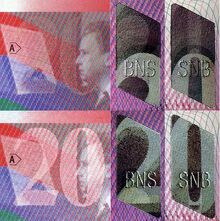
Security features on the eighth series.
The current, eighth series of banknotes, which was designed by Jörg Zintzmeyer in accordance to the theme of arts, was issued starting in 1995. In additions to new designs, this series was different than the previous sixth series on several counts. Sometimes considered the most prominent was the replacement of the seldom-used 500 franc banknote with the 200 franc note, which has proved more successful than the 500 franc note. The colors of the eighth series were kept similar to the notes of the sixth series, except that the 20 franc note was changed from blue to red to avoid confusion between it and the 1000 franc note, and the 10 franc note was changed from red to yellow. Like its preceding series, it was designed in a vertical orientation, but on both sides rather than one. The size was changed as well, with all notes having the same height of 74 millimeters, while the widths were changed, increasing with the notes' value. Security features were also added to these notes, and many of these have been visibly displayed and advertised, in contrast to the sixth series, where these security features were kept secret.
All of the banknotes are printed in four of Switzerland's national languages. The banknotes that depict German or Romansh people have German and Romansh on the same side of the picture, while banknotes displaying a French or Italian person have French and Italian on the same side of the picture. On the reverse, the two other languages are displayed.
Image
|
Value
|
Dimensions
|
Color
|
Obverse
|
Reverse
|
Issued
| |
Obverse
|
Reverse
| ||||||

|

|
10 francs | 126 × 74 mm | yellow | Le Corbusier | Palace of Justice, Modulor | April 8, 1997 |

|

|
20 francs | 137 × 74 mm | red | Arthur Honegger | Pacific 231, instrument | October 1, 1996 |
| 50 francs | 148 × 74 mm | green | Sophie Taeuber-Arp | "Relief rectangulaire", "Tête Dada", "Aubette", "Lignes ouvertes" | October 3, 1995 | ||
| 100 francs | 159 × 74 mm | blue | Alberto Giacometti | Lotar II, Homme qui marche, space-time | October 1, 1998 | ||
| 200 francs | 170 × 74 mm | brown | Charles-Ferdinand Ramuz | Mountain, lake, manuscript | October 1, 1997 | ||
| 1000 francs | 181 × 74 mm | purple | Jacob Burckhardt | Ancient Architecture | April 1, 1998 | ||
Future notes[]

|
This article or section contains information on an expected future introduction.
When the subject has been officially introduced, remove this message. |
In February 2005, the Swiss National Bank held a competition to help determine the design of the new ninth series, which was planned to be released in 2010 on the theme, Switzerland open to the world. Twelve people were chosen, and the designs of the first place winner, Manuel Krebs, were originally chosen, but after criticism by the public, the National Bank of Switzerland chose second place winner, Manuela Pfrunder's designs. These are scheduled to be issued in 2012.
Circulation[]

|
This page uses Creative Commons Licensed content from Wikipedia (view authors). |
As of March 2010, the total value of released 49,664.0 million francs.
| Value of Swiss coins and banknotes in circulation as of March 2010 (in millions of CHF) | ||||||||
| Coins | 10 francs | 20 francs | 50 francs | 100 francs | 200 francs | 500 francs | 100 francs | Total |
| 2695.4 | 656.7 | 1416.7 | 1963.0 | 8337.4 | 6828.0 | 129.9 | 27,637.1 | 49,664.0 |
Reserve currency[]
The Swiss franc is globally used as a reserve currency and currently ranks 5th or 6th in value held as reserves after the United States dollar, euro, Japanese yen, and pound sterling.
| v • d • e | '95 | '96 | '97 | '98 | '99 | '00 | '01 | '02 | '03 | '04 | '05 | '06 | '07 | '08 | '09 | '10 | Latest Data '11 Quarter I |
|---|---|---|---|---|---|---|---|---|---|---|---|---|---|---|---|---|---|
| US dollar | 59.0% | 62.1% | 65.2% | 69.3% | 70.9% | 70.5% | 70.7% | 66.5% | 65.8% | 65.9% | 66.4% | 65.7% | 64.1% | 64.1% | 62.1% | 61.5% | 60.7% |
| Euro | 17.9% | 18.8% | 19.8% | 24.2% | 25.3% | 24.9% | 24.3% | 25.2% | 26.3% | 26.4% | 27.6% | 26.2% | 26.6% | ||||
| German mark | 15.8% | 14.7% | 14.5% | 13.8% | |||||||||||||
| French franc | 2.4% | 1.8% | 1.4% | 1.6% | |||||||||||||
| Pound sterling | 2.1% | 2.7% | 2.6% | 2.7% | 2.9% | 2.8% | 2.7% | 2.9% | 2.6% | 3.3% | 3.6% | 4.2% | 4.7% | 4.0% | 4.3% | 4.0% | 4.1% |
| Japanese yen | 6.8% | 6.7% | 5.8% | 6.2% | 6.4% | 6.3% | 5.2% | 4.5% | 4.1% | 3.9% | 3.7% | 3.2% | 2.9% | 3.1% | 2.9% | 3.8% | 3.8% |
| Swiss franc | 0.3% | 0.2% | 0.4% | 0.3% | 0.2% | 0.3% | 0.3% | 0.4% | 0.2% | 0.2% | 0.1% | 0.2% | 0.2% | 0.1% | 0.1% | 0.1% | 0.1% |
| Other | 13.6% | 11.7% | 10.2% | 6.1% | 1.6% | 1.4% | 1.2% | 1.4% | 1.9% | 1.8% | 1.9% | 1.5% | 1.8% | 2.2% | 3.1% | 4.4% | 4.7% |
| Sources: 1995-1999, 2006-2010 IMF: Currency Composition of Official Foreign Exchange Reserves Sources: 1999-2005 ECB: The Accumulation of Foreign Reserves | |||||||||||||||||
Exchange rates[]
| Current CHF exchange rates | |
|---|---|
| From Google Finance [1]: | AUD CAD EUR GBP HKD JPY USD |
| From Yahoo! Finance [2]: | AUD CAD EUR GBP HKD JPY USD |
| From OzForex [3]: | AUD CAD EUR GBP HKD JPY USD |
| From XE.com [4]: | AUD CAD EUR GBP HKD JPY USD |
| From OANDA.com [5]: | AUD CAD EUR GBP HKD JPY USD |
References[]
Swiss franc on the English Wikipedia
Schweizer Franken on the German (Deutsch) Wikipedia
- Swiss Federal Constitution of 1874 on Wikisource
| Swiss franc | |
|---|---|
| Banknotes | 5 CHF • 10 CHF • 20 CHF • 40 CHF • 50 CHF • 100 CHF • 200 CHF • 500 CHF • 1000 CHF |
| Coins | 1 rappen (HR) • 2 rappen • 5 rappen • 10 rappen • 20 rappen • ½ batzen • 1 batzen • 5 batzen • 10 batzen • 20 batzen • ½ CHF • 1 CHF • 2 CHF • 40 batzen • 4 CHF • 5 CHF • 10 CHF • 16 CHF • 20 CHF • 25 CHF • 32 CHF • 50 CHF • 100 CHF • 200 CHF • 250 CHF • 500 CHF • 1000 CHF
1⁄10 unze • ¼ unze • ½ unze • 1 unze • 5 unze • 12 unze • ₠1 • ₠5 • 1 ceros • 2 ceros • 5 ceros • 10 ceros • 20 ceros • 50 ceros • 1 europ • 2 europ • 5 europ • 1 silbertaler • 20 rond |
| Miscellaneous | Bern Mint • Basel Mint • Liechtenstein frank • Orell Füssli Arts Graphiques SA • Solothurn Mint • Swiss National Bank • Swissmint |
